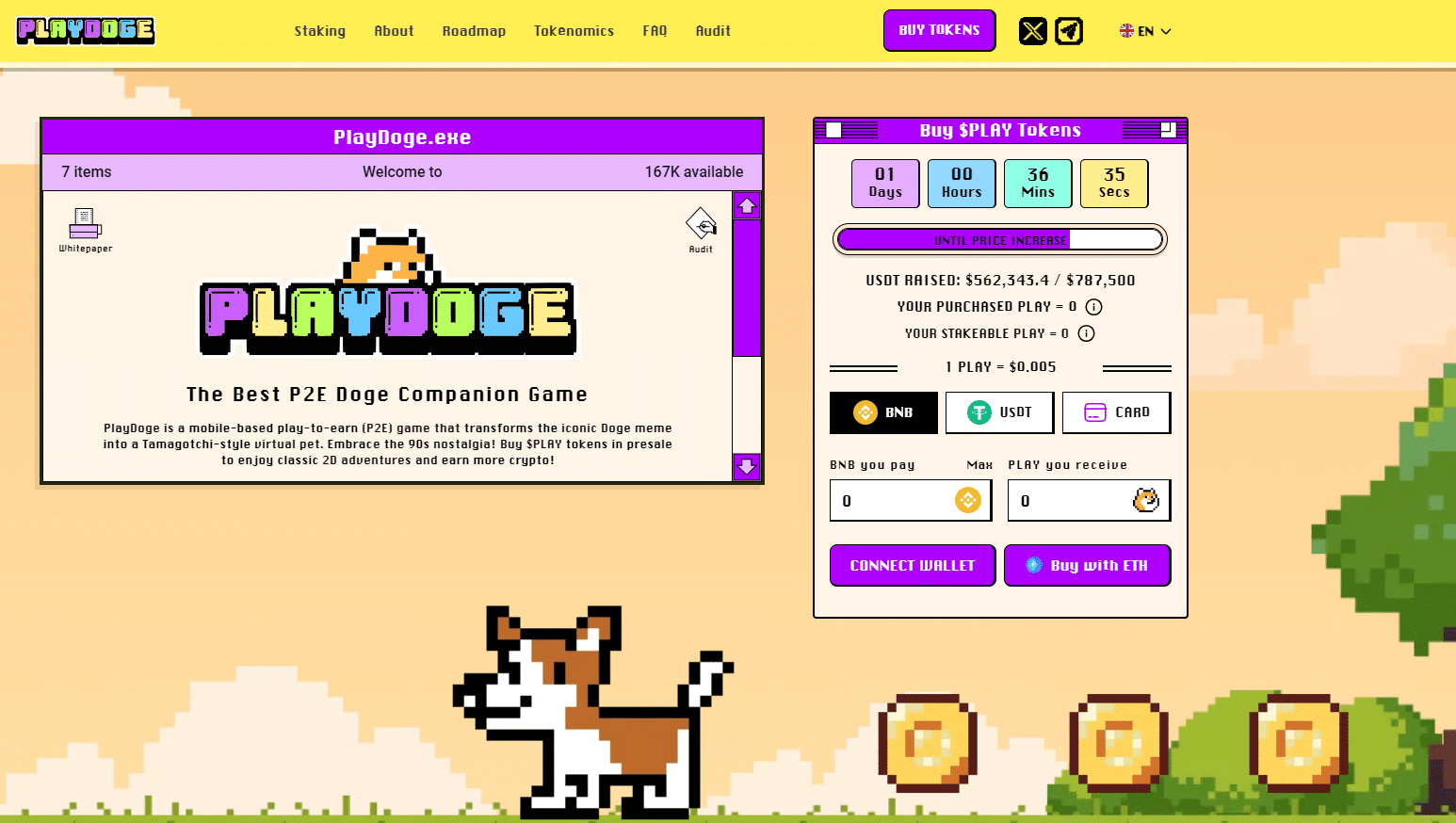Exploring the Best DePIN Cryptocurrency Projects in 2024
Wednesday, August 21, 2024 2:46 PM
1,407

Top DePIN Cryptocurrencies for 2024 include PlayDoge, Render, BitTorrent, Filecoin, Theta Network, MultiversX, Ocean Protocol, Livepeer, Storj, and World Mobile Token. These projects offer decentralized real-world infrastructure ecosystems like GPU rendering, cloud storage, and internet access. PlayDoge stands out with its P2E game and meme appeal, while Render provides peer-to-peer GPU rendering services. The DePIN sector is expected to grow as more users participate, making these coins potentially lucrative investments.
Buy Now at
Related News

4 days ago
Io.net Unveils New Token Model to Enhance Decentralized AI Compute NetworkIo.net has introduced a revamped token model for its decentralized AI compute network, aiming to better align token rewards with actual usage and demand. The new framework, named the Incentive Dynamic Engine (IDE), is designed to optimize how native tokens are issued and allocated among hardware providers, users, and investors. Since June, Io.net's distributed network of graphics processing units (GPUs) has facilitated over $20 million in compute leases, highlighting the growing demand for decentralized AI training and inference workloads.
The IDE employs a dynamic control system that adjusts token release and payout levels based on real-time network conditions. This innovative approach contrasts with previous models that relied on high token rewards to stimulate supply, which often resulted in persistent inflation and misalignment with end-user demand. By stabilizing income for GPU providers across more than 130 countries and promoting predictable pricing for users, Io.net aims to create a more reliable and open market for compute resources. Gaurav Sharma, CEO of Io.net, emphasized the importance of transitioning from centralized hyperscalers to decentralized markets for compute, asserting that IDE represents a pioneering step toward this goal.
Despite the potential of decentralized compute networks, large enterprises have been hesitant to adopt them due to concerns about reliability and transparency. Io.net's IDE framework addresses these issues by enhancing visibility into network data, thereby fostering trust among corporate users. The model also includes deflationary mechanisms that link token flows to real-world usage, reducing income volatility for GPU providers and rewarding investors who support actual network utilization. With the IDE proposal currently open for community feedback, Io.net plans to finalize its tokenomics design by March and roll out the new model in the second quarter of 2026, positioning itself as a key player in the decentralized AI landscape.

5 days ago
Filecoin Faces Significant Decline as Market Sentiment ShiftsFilecoin (FIL) has experienced a significant decline of 7.3% over the past 24 hours, dropping from $1.48 to $1.38. This downturn has pushed the token below the crucial support level of $1.43, establishing a new support at $1.37. The recent selloff has been attributed to a broader liquidation in decentralized physical infrastructure tokens, which has negatively impacted the entire sector. CoinDesk Research's technical analysis indicates that Filecoin has been in a downtrend, marked by consecutive lower highs since its peak at $1.55 on December 10. The trading volume surged to 10.6 million tokens during this breakdown, highlighting the intensity of the market's reaction.
The failure of Filecoin to reclaim the resistance level at $1.52 has intensified selling pressure, with an 85% spike in trading volume confirming institutional selling as the price broke through the critical support at $1.43. Following this, the price stabilized near session lows around $1.37, suggesting a temporary exhaustion of selling momentum. The current technical outlook indicates that if the support at $1.37 fails, the price could target the downside range of $1.30 to $1.35. Meanwhile, the broader cryptocurrency market also faced challenges, with Bitcoin slipping below $91,000 and the CoinDesk 20 index declining by 3.4% at the time of publication.
In other news, the Cardano ecosystem has received a boost with the launch of Midnight's NIGHT token, which aims to enhance privacy on the network. The token has already doubled in value, approaching a $1 billion valuation, as it introduces a programmable privacy layer utilizing zero-knowledge proofs. This innovative approach allows for the separation of public and private data while enabling controlled disclosures to relevant parties. The launch also features a cross-chain allocation model that distributes NIGHT tokens across various ecosystems, promoting a collaborative privacy environment. This development highlights the ongoing evolution of blockchain technology and its applications in enhancing user privacy and security.

5 days ago
io.net Launches Innovative Incentive Dynamic Engine to Transform AI Compute MarketOn December 11, 2025, io.net unveiled its groundbreaking Incentive Dynamic Engine (IDE), a significant overhaul of its tokenomics aimed at fostering a resilient and open market for AI model training and deployment hardware. Since its inception in June 2024, io.net has facilitated over $20 million in compute leases, providing affordable access to AI innovators and researchers through its extensive GPU network. The IDE is designed to align the incentives of all stakeholders, ensuring reliable income for hardware providers and stable pricing for users, thereby enhancing the long-term health of the network.
The previous tokenomics model of io.net faced criticism for creating inflationary pressures and leaving the network susceptible to market fluctuations. Concerns regarding the circular nature of hardware and compute agreements in AI development have hindered further investment. The introduction of the IDE aims to establish a trustworthy market that directly connects hardware providers with users, allowing for confident capital deployment by investors and manufacturers. This new model is expected to mitigate the risks associated with decentralized physical infrastructure networks (DePINs), which have struggled to meet the demands of the AI sector.
Gaurav Sharma, CEO of io.net, emphasized the importance of transitioning from centralized hyperscalers to decentralized, open markets for compute. The IDE is positioned as a pioneering solution that will enhance the growth of io.net by providing a reliable and transparent compute network. The launch of the IDE will not only stabilize income for GPU providers but also promote real-world utility for investors, ultimately creating a more robust compute network for users. The io.net community will have the opportunity to provide feedback on the new tokenomics proposal until February 27, with a final version set to be implemented in Q2 2026.

5 days ago
io.net Unveils Incentive Dynamic Engine to Revamp Tokenomicsio.net, a decentralized physical infrastructure network (DePIN) focused on AI compute, has announced a significant overhaul of its tokenomics with the introduction of the Incentive Dynamic Engine (IDE). This new demand-driven model aims to provide long-term stability for suppliers, users, and token holders by moving away from fixed token emissions. Instead, it will implement an automated system that adjusts emissions, buys back tokens, and burns a portion of revenue to mitigate inflationary pressures. Since its launch in June last year, io.net has processed over $20 million in verifiable compute leases, demonstrating real usage demand and necessitating this transition from a bootstrapping phase to a more stable foundation for enterprise and research workloads.
At the core of IDE is a shift from a supply-driven rewards schedule to a real-time, demand-driven control system. This mechanism utilizes two counter-cyclical vaults and a “sustainability ratio” to balance payouts and reserves automatically. When revenue is high, the system retains tokens in reserve, while in times of lower demand, it releases tokens to stabilize supplier payouts. This approach aims to make supplier income predictable and enhance the network's resilience across varying market cycles, addressing the risks associated with the previous fixed-emissions model.
Moreover, IDE incorporates a built-in deflationary mechanism, committing to using at least 50% of remaining revenue to purchase and permanently burn $IO tokens, with a target of removing over 150 million tokens from circulation over time. The proposal is currently open for community review, with feedback being collected until late February, and a final design is expected to be published ahead of a planned rollout in Q2 2026. Gaurav Sharma, CEO of io.net, emphasized the importance of this shift in enabling decentralized compute markets and aligning incentives for GPU providers, users, and investors, ultimately fostering a reliable and open compute network for AI systems.

5 days ago
Cryptocurrency Market Faces Widespread DeclinesIn the latest update from ChainCatcher News, the cryptocurrency market has experienced a notable pullback across most sectors. The DePIN sector has been particularly hard hit, leading the decline with a drop of 4.28% over the past 24 hours. Within this sector, Filecoin (FIL) saw a significant decrease of 7.50%, while Render (RENDER) fell by 5.52%. Major cryptocurrencies also faced downward pressure, with Bitcoin (BTC) dropping 1.41% to fall below the $91,000 mark, and Ethereum (ETH) declining 1.02%, dipping under $3,300.
Other sectors have not been immune to this trend. The CeFi sector saw a 1.00% decline, with Cronos (CRO) down 3.39%. The Layer2 sector experienced a 2.15% drop; however, Mantle (MNT) managed to resist the trend, posting a modest gain of 1.12%. In the DeFi sector, a 2.35% decrease was noted, although Hyperliquid (HYPE) defied the odds with a 2.95% increase. The Layer1 sector fell by 2.54%, with Zcash (ZEC) suffering a notable 10.78% drop after previous gains. The PayFi sector also saw a decline of 2.92%, despite Ultima (ULTIMA) surging 6.63% intraday.
The AI sector was not spared either, dropping 3.85%, although Pieverse (PIEVERSE) stood out with a remarkable increase of 28.38%. The Meme sector fell by 3.88%, yet PIPPIN (PIPPIN) rose by 6.67%. Overall, the ssiAI, ssiNFT, and ssiDePIN indices reflected these declines, falling by 5.55%, 5.32%, and 5.16%, respectively. It is important to note that this analysis is based solely on the author's perspective and should not be construed as investment advice.

6 days ago
Helium Expands into Brazil: A Bold Move for DePIN and Crypto RewardsIn a significant development for decentralized infrastructure, the Helium Network is expanding its operations into Brazil, marking a bold move for the Decentralized Physical Infrastructure Network (DePIN). This Solana-based project has partnered with local internet service provider Mambo WiFi to deploy Helium hotspots across Brazil. These hotspots allow individuals and businesses to provide wireless coverage while earning Helium's native cryptocurrency, HNT, based on their hotspot usage. This innovative model not only incentivizes participants to become stakeholders but also fosters the growth of a crowdsourced telecom infrastructure in South America’s largest economy.
The expansion into Brazil is a strategic decision that validates the DePIN model, particularly in a country with diverse geography and varying internet connectivity levels. By tapping into Brazil's potential user base, Helium is creating new earning opportunities for residents who can monetize their internet connections by sharing bandwidth. Additionally, the increase in hotspots will strengthen the Helium network, enhancing its reliability for Internet of Things (IoT) devices. However, the project faces challenges such as local regulatory navigation and maintaining an attractive economic model amidst the volatility of the crypto market.
For those interested in participating, acquiring a Helium-compatible hotspot through Mambo WiFi is straightforward. Once installed, the device will contribute to the Helium Network, facilitating IoT data transmission and earning HNT tokens based on its performance. This expansion not only serves as a potential blueprint for Helium's future endeavors in other emerging markets but also highlights the scalability and economic viability of the DePIN model. As Helium operates on the Solana blockchain, it benefits from faster transactions and lower costs, making it easier for hotspot operators to earn micro-rewards. Overall, Helium's Brazilian expansion represents a pivotal moment for decentralized networks, offering real-world utility and earning potential while paving the way for a more decentralized internet infrastructure globally.
Signup for latest DePIN news and updates